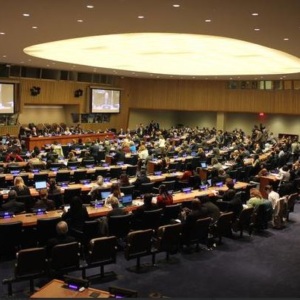Lame Excuse: Rubio Cuts Off Funding to the United Nations Population Fund (UNFPA)

The 48th Session of the Commission on Population and Development (CPD48) is well underway this week at the United Nations. This year’s topic is “Realizing the Future We Want: Integrating Population Issues into Sustainable Development, Including the Post-2015 Development Agenda.”
The informal sessions began last week and many fresh faces arrived in the halls of the UN this week from capitals around the world to advocate for the most important issues for their countries. The Financing for Development preparatory meetings are simultaneously taking place across the building. And conversations will flow into next week’s inter-sessional on Mean of Implementation for the Sustainable Development Goals (SDGs). Needless to say, there is a lot going on, and much to coordinate through parallel and converging themes and processes.
CPD48 is focused on the relationships between population dynamics, sustainable development and human rights. It’s a big topic, so it’s a good thing we’re not starting from scratch. As the name reflects, this is the 48th Session of this Commission and there is strong existing language to draft from for each of these topics. In fact, IPPF yesterday re-launched an app that collates the strongest language on various topics from past agreements. You can check it out here.
This year, we are facing some new and exciting horizons. Outlined below are some of the hot topics being discussed during this week’s negotiations.
This is the first time there has been a robust conversation about the demographic dividend, the economic growth that may result from changes to a country’s age structure, considered for inclusion in CPD. Delegates, civil society, and academics alike affirm the need for empowerment, quality education, and health care to achieve the demographic dividend. A draft paragraph in the current CPD text recognizes youth empowerment as critical to achieve social and economic transformation. At PAI, we understand making sure people can access family planning is a fundamental step toward achieving the demographic dividend, and we’re glad to see this included in the text.
At this point, there’s no denying the implications of climate change on our planet. UN Department of Economic and Social Affairs (UN DESO) released a set of resources which notably includes a section on environmental sustainability, and the Economic and Social Council (ECOSOC) highlights that CO2 emissions are far more uncertain than the population growth rate, as seen in their chart on page 28. Current drafts include the language that was also incorporated into last year’s CPD documents on climate adaptation and mitigation. This has been met with widespread support.
More than 150 civil society advocates and government representatives came together early this week to reaffirm our commitment to sexual and reproductive health and rights (SRHR) and comprehensive sexuality education (CSE). PAI contributed to the final statement of the International Sexual and Reproductive Rights Caucus (ISRRC), which states:
“Sustainable development will only occur when all individuals fully realize their sexual rights. As governments agreed more than 20 years ago, human rights include the right to have control over and decide freely on all matters related to one’s sexuality, free from coercion, discrimination, and violence.”
We hope governments heed this call to action.
We see the issues of this year’s CPD as fundamental not only for each woman and family, but to achieving sustainable development. Professor Tim Dyson, a demography professor at the London School of Economics and a keynote speaker, summed up the sentiment and aspiration of the week by saying “in the world’s least developed countries, if we really want to improve children’s health, the status of women, education access, address problems caused by rapid urban growth, conserve the environment, and alleviate poverty, there are few better ways than making sure that people have access to safe, effective, affordable, and modern means of birth control—as a basic human right.”
We hope these two important processes, CPD and the SDGs, continue to support each other so SRHR can be fully integrated and realized in the post-2015 development agenda.
We are fighting back against the onslaught of harmful policies that discard reproductive rights.
Stay informed about the issues impacting sexual and reproductive health and rights.
